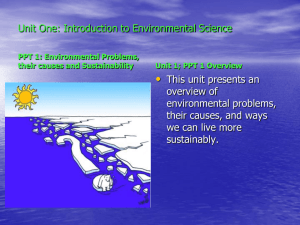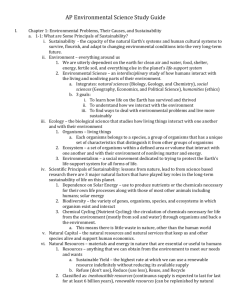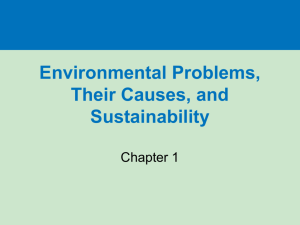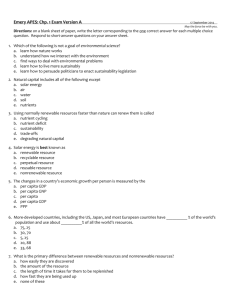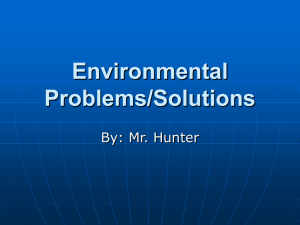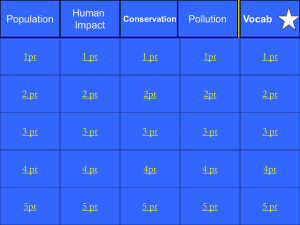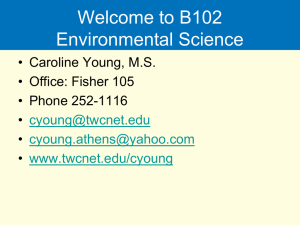Environmental Problems, Their Causes, and Sustainability
advertisement
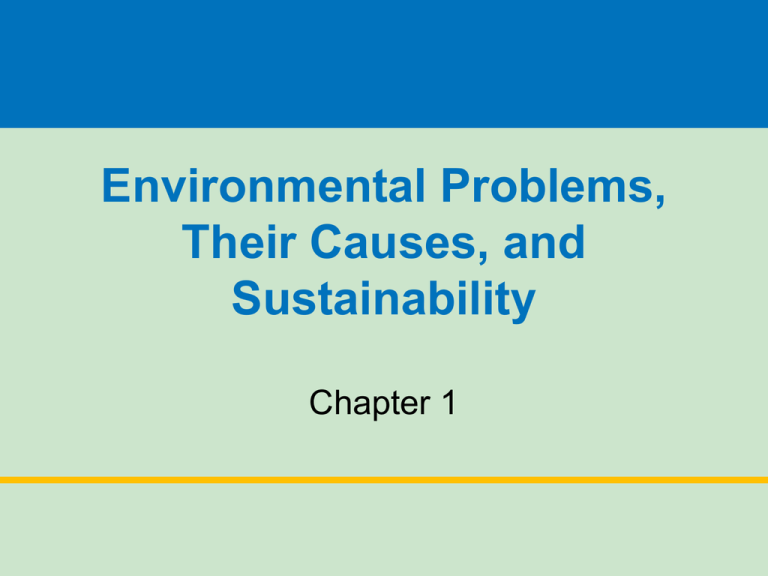
Environmental Problems, Their Causes, and Sustainability Chapter 1 Sustainability What is sustainability? • Sustainability is the capacity of the earth’s natural systems and human cultural systems to survive, flourish and adapt to changing environmental conditions into the very long-term future. WHAT ARE THREE PRINCIPLES OF SUSTAINABILITY? Section 1-1 Environmental science is a study of connections in nature • Environment includes all living and nonliving things with which an organism interacts. • Ecology studies relationships between living organisms, and their interaction with the environment. What is Environmental Science? • Opinions? • Ideas? topics • • • • • • • Recycling Global warming Fuel shortages Alternative energy Invasive Species Overfishing Etc. Relationship between Environmental Science and Environmentalism Environmental Science Environmentalism • Environmental science studies how the earth works, our interaction with the earth, and ways to deal with environment problems and live more sustainably. • Environmentalism is a social movement dedicated to protecting life support systems for all species Disclaimer The purpose of this class is not to convert you to environmentalism but to educate you in environmental science and make you aware of current environmental issues. Back to Sustainability • https://www.youtube.com/watch?v=B5NiT N0chj0 • https://www.youtube.com/watch?v=Qp3eo oTJkY4 • https://www.youtube.com/watch?v=GnYH FRq7-5s Three principles of sustainability 1. Life depends on solar energy. 2. Biodiversity provides natural services. – Biodiversity – variety of different species, genetic variability among individuals within each species, variety of ecosystems 3. Chemical/nutrient cycling means that there is little waste in nature. Figure 1.4 Ecosystem O2 O2 Sunlight Heat Producers (such as plants) Consumers (such as animals) Chemical energy (food) CO2 Water and minerals taken up by tree roots CO2 Cycling of chemical nutrients Decomposers (in soil) Three principles of sustainability Sustainability has certain key components 1. Life depends on natural capital = natural resources and natural services. 2. Many human activities can degrade natural capital. 3. Solutions are being found and implemented. 4. Sustainability begins at personal and local levels. Solar energy Natural Capital Natural Capital = Natural Resources + Natural Services Air Renewable energy (sun, wind, water flows) Air purification Climate control UV protection (ozone layer) Life (biodiversity) Population control Water Water purification Pest control Waste treatment Soil Nonrenewable minerals (iron, sand) Soil renewal Land Food production Nutrient recycling Nonrenewable energy (fossil fuels) Natural resources Natural services Fig. 1-3, p. 9 Organic matter in animals Dead organic matter Organic matter in plants Decomposition Inorganic matter in soil Fig. 1-4, p. 10 Some resources are renewable and some are not • Humans depend on resources to meet our needs. – Water – Food – Electricity - Housing - Etc. Where can these resources come from? • Renewable vs. Nonrenewable • Renewable resources are things which cannot be used up • Nonrenewable resources are usually things which are dug out of the earth and can be used up Renewable Resources • A renewal resource, also known as a perpetual resource, is continuously renewed and expected to last (e.g. solar energy). • A renewable resource is replenished in days to several hundred years through natural processes. Sustainable Yield • Sustainable yield is the highest rate at which a renewable and non-renewable resource can be used indefinitely without reducing its available supply. (harvestable surplus) – Forestry – Fisheries Some resources are renewable and some are not • Some resources are not renewable. – Nonrenewable resources exist in fixed quantities. – Exhaustible energy (e.g. coal and oil). – Metallic minerals (e.g. copper and aluminum). – Nonmetallic minerals (e.g. salt and sand). • Sustainable solutions: Reduce, reuse, recycle. HOW ARE OUR ECOLOGICAL FOOTPRINTS AFFECTING THE EARTH? Section 1-2 We are living unsustainably • Scientific evidence indicates that we are living unsustainably. • Environmental, or natural capital, degradation is occurring. • However, we have solutions to these problems that can be implemented. Natural Capital Degradation Degradation of Normally Renewable Natural Resources Climate change Shrinking forests Decreased wildlife habitats Air pollution Soil erosion Species extinction Water pollution Aquifer depletion Declining ocean fisheries Fig. 1-5, p. 11 Pollution comes from a number of sources 1. Point sources - are single, identifiable sources (e.g., smokestack). 2. Nonpoint sources - are dispersed and often difficult to identify (e.g., lawn runoff). • We can clean up pollution or prevent it. – Pollution cleanup is usually more expensive and less effective. – Pollution prevention reduces or eliminates the production of pollutants. Environmental degradation • Environmental degradation is the deterioration of the environment through depletion of resources such as air, water and soil; the destruction ofecosystems and the extinction of wildlife. It is defined as any change or disturbance to the environment perceived to be deleterious or undesirable. The tragedy of the commons: overexploiting shared renewable resources • In 1968, the biologist Garrett Hardin called the degradation of openly shared resources the tragedy of the commons. Tragedy of the Commons • https://www.youtube.com/watch?v=L8gAM FTAt2M 2 ways to prevent degradation: 1. Reduce use by government regulations. • Like regulating fishing for example. 2. Shift to private ownership – such as land. The idea is that if you own it you are more likely to take care of it. Ecological footprints: our environmental impacts • Ecological footprint - the amount of biologically productive land and water needed to supply a person or country with renewable resources and to recycle the waste and pollution produced by such resource use. Per Capita Ecological Footprint • Per capita ecological footprint - the average ecological footprint of an individual in a given country or area Ecological footprints: our environmental impacts • Ecological deficit means the ecological footprint is larger than the biological capacity to replenish resources and absorb wastes and pollution. • Humanity is living unsustainably. • Footprints can also be expressed as number of Earths it would take to support consumption. Total Ecological Footprint (million hectares) and Share of Global Biological Capacity (%) United States 2,160 (19%) European Union United States 2,810 (25%) European Union China India Japan Per Capita Ecological Footprint (hectares per person) China 2,050 (18%) 780 (7%) India 9.7 4.7 1.6 0.8 Japan 540 (5%) 4.8 Number of Earths 2.5 Unsustainable living 2.0 1.5 Projected footprint 1.0 Ecological footprint 0.5 0 1961 1970 1980 1990 2000 Sustainable living 2010 2020 2030 2040 2050 Year Fig. 1-8, p. 14 How big is a hectare? IPAT is another environmental impact model • In the early 1970s, scientists Paul Ehrlich and John Holdren developed the IPAT model. • I (environmental impact) = P (population size) x A (affluence/person) x T (technology’s beneficial and harmful effects). I=PxAxT Section 1-3 WHY DO WE HAVE ENVIRONMENTAL PROBLEMS? Experts have identified four basic causes of environmental problems 1. 2. 3. 4. Population growth. Unsustainable resource use. Poverty. Excluding environmental costs from market prices. The human population is growing exponentially at a rapid rate • Human population is increasing at a fixed percentage so that we are experiencing doubling of larger and larger populations. • Human population in 2009 was about 6.8 billion. • http://www.census.gov/popclock/ Human population growth • Based on the current increase rate there will be 9.6 billion people by 2050. • We can slow population growth. – Developing countries have the highest population growth because of poverty and the inability to pay for contraceptives. Exponential growth Affluence has harmful and beneficial environmental effects • Wealth results in high levels of consumption and waste of resources. • Average American consumes 30 times as much as the average consumer in India. • “Shop-until-you-drop” affluent consumers are afflicted with a disorder called affluenza. • Affluence has provided better education, scientific research, and technological solutions, which result in improvements in environmental quality (e.g., safe drinking water). Poverty has harmful environmental and health effects • Poverty occurs when the basic needs for adequate food, water, shelter, health, and education are not met. • One in every five people live in extreme poverty (<$1.25/day), and more are susceptible. Poverty has harmful environmental and health effects • Poverty causes harmful environmental and health effects. – Environmental degradation caused by need for short-term survival. – Malnutrition. – Inadequate sanitation and lack of clean drinking water. – Severe respiratory disease. – High rates of premature death for children under the age of 5 years. Harmful effects of poverty Prices of goods and services do not include harmful environmental and health costs • A company’s goal is often to maximize the profit. • Often consumers do not know the damage caused by their consumption. • Government subsidies may increase environmental degradation – ie tax breaks. • There are ways to include harmful costs of goods and services. 1. Shift from environmentally harmful (clearing forests, fishing, coal…) to beneficial government subsidies (renewable energy). 2. Tax pollution and waste heavily while reducing taxes on income and wealth. People have different views about environmental problems and their solutions • Each individual has their own environmental worldview—a set of assumptions and values reflecting how you think the world works and what your role should be. Environmental Worldviews Planetary Management ■ We are apart from the rest of nature and can manage nature to meet our increasing needs and wants. ■ Because of our ingenuity and technology, we will not run out of resources. ■ The potential for economic growth is essentially unlimited. ■ Our success depends on how well we manage the earth's life- support systems mostly for our benefit. Stewardship ■ We have an ethical responsibility to be caring managers, or stewards, of the earth. ■ We will probably not run out of resources, but they should not be wasted. ■ We should encourage environmentally beneficial forms of economic growth and discourage environmentally harmful forms. ■ Our success depends on how well we manage the earth's lifesupport systems for our benefit and for the rest of nature. Environmental Wisdom ■ We are a part of and totally dependent on nature, and nature exists for all species. ■ Resources are limited and should not be wasted. ■ We should encourage earthsustaining forms of economic growth and discourage earthdegrading forms. ■ Our success depends on learning how nature sustains itself and integrating such lessons from nature into the ways we think and act. Stepped Art Fig. 17-19, p. 455 Environmental Ethics • Environmental ethics are beliefs about what is right and wrong with how we treat the environment. - Why should we care about the environment? - How do we promote sustainability? - Are we the most important organisms on the planet or are other organisms just as important? Section 1-4 WHAT IS AN ENVIRONMENTALLY SUSTAINABLE SOCIETY? What is an environmentally sustainable society? • Environmentally sustainable societies protect natural capital and live off its income. 1. Increase reliance on renewable resources. 2. Protect earth’s natural capital. https://www.youtube.com/watch?v=L8mXDsGiiu4 https://www.youtube.com/watch?v=wDM-swSM9T0 Eco villages • https://www.youtube.com/watch?v=ilKaQj HOIZY • https://www.youtube.com/watch?v=ZLQ75 ZBG2ng • https://www.youtube.com/watch?v=3i1EC Ca9u6g • https://www.youtube.com/watch?v=t2RSF 9KNokc Three Big Ideas 1. Rely more on renewable energy from the sun. 2. Protect biodiversity by preventing the degradation of the earth’s species, ecosystems, and natural processes, and by restoring areas we have degraded. 3. Help sustain earth’s natural chemical cycles by reducing waste and pollution, not overloading natural systems with chemicals, and don’t remove natural chemicals faster than the cycles can replace them.
